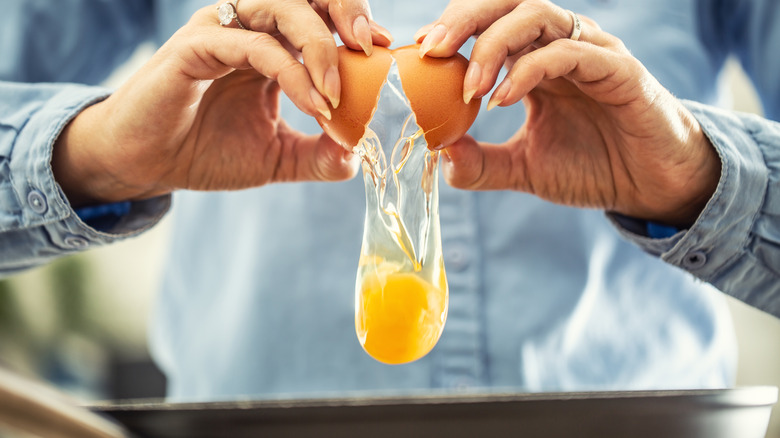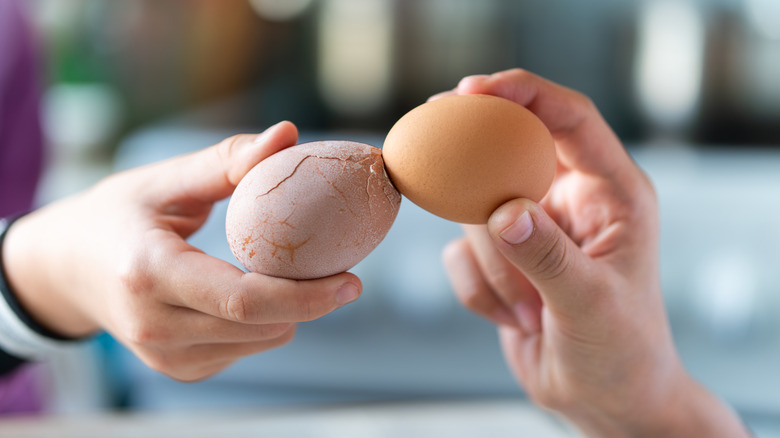Here's How Professional Chefs Crack Tons Of Eggs So Efficiently
When it comes to using eggs, most of the time, we're cracking one or two into a hot pan to make the perfect fried egg. Perhaps we're safely bring a few up to room temperature since that's the best temperature for making cake mix or chocolate chip cookies. Maybe you're cooking scrambled eggs for a small army of hungry people, or you're in charge of all the cakes for this year's school fundraiser. Whatever the case, it can get tedious using both hands, carefully separating each egg, and lightly shaking out the contents. Surely there's a faster way. In fact, chefs have several different strategies when cracking many eggs for a recipe.
You've probably witnessed a chef impressively crack an egg with one hand and then quickly toss the shells into the compost bin. It speeds up the process, and it has the added bonus of looking cool. However, it's only one cracking technique the pros use. Chefs balance speed with precision in pretty much everything they do, and the same is true with eggs.
Crack eggs faster with one hand
One-handed cracking doesn't just impress, it also speeds up the process. To pull this egg-cracking trick off, grab an egg like you're throwing a knuckleball or popping a beer can and hit it just right against the edge of a bowl or cup so the shell splits. Then, pull it apart with your palm and fingertips and dump the contents. You can even reach for the next egg with your other hand simultaneously or be really efficient and crack two eggs at once. With warm water running, rinse the shells clean before dropping them in the bin.
There are challenges to this approach, particularly when dealing with brittle shells. It's a technique that takes practice. If you don't use enough pressure, the halves won't pull apart. Too much will crush the whole thing in your hand and eject shell fragments into the bowl. There's a legitimate reason to use caution when it comes to the shells, as they can host salmonella. So not only are you digging around in egg goo for errant bits of shell, but there's also a small risk of introducing unwanted bacteria.
If you notice, we recommend cracking your eggs into a bowl rather than straight into the frying pan or cake mix. This pro tip doesn't directly speed up the process, but it gives you the chance to remove bits of shell before they end up in your finished dish.
Alternative egg-cracking approaches focus on efficiency
Cracking an egg on the edge of the bowl not only runs the risk of shell fragments but also increases the risk of breaking a yolk. That can completely ruin a whole bowl of eggs that still needs separating. For a lot of chefs, including José Andrés (who has beef with the rim approach), the only proper method is to crack an egg against a countertop.
Advocates for this method swear that it's not only less messy but actually faster. It's also useful if you're employing a production line. One person focuses on grabbing eggs and cracking them on the counter while another separates each shell, pouring eggs into a bowl. There are also people who combine the countertop strike with a one-handed final crack and pour, or even trickier, the one-handed separation of whites and yolks.
Two other popular methods of efficiently cracking eggs involve different levels of confidence. One way is to cup the egg in one hand and crack the middle with the back of a knife. There's some risk of shell fragments and yolk breaking, but it's a pretty easy technique to master. The other is for the dedicated pro. Hold two eggs, one in each hand, and crack the sides against each other. Then, do the one-handed trick with each hand. So much can go wrong here, but once you get it down, you'll impress the heck out of your household.


